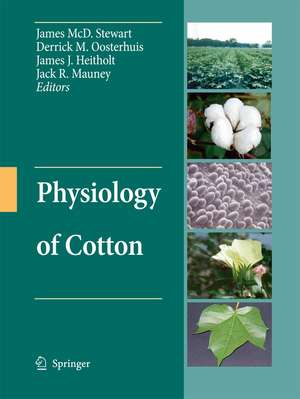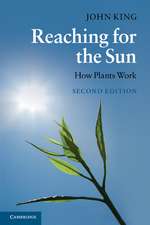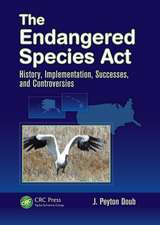Physiology of Cotton
Editat de James McD. Stewart, Derrick Oosterhuis, James J. Heitholt, Jack R. Mauneyen Limba Engleză Paperback – 2 noi 2014
| Toate formatele și edițiile | Preț | Express |
|---|---|---|
| Paperback (1) | 671.48 lei 43-57 zile | |
| SPRINGER NETHERLANDS – 2 noi 2014 | 671.48 lei 43-57 zile | |
| Hardback (1) | 611.46 lei 38-44 zile | |
| SPRINGER NETHERLANDS – 5 noi 2009 | 611.46 lei 38-44 zile |
Preț: 671.48 lei
Preț vechi: 789.97 lei
-15% Nou
Puncte Express: 1007
Preț estimativ în valută:
128.48€ • 134.51$ • 106.31£
128.48€ • 134.51$ • 106.31£
Carte tipărită la comandă
Livrare economică 07-21 aprilie
Preluare comenzi: 021 569.72.76
Specificații
ISBN-13: 9789400790551
ISBN-10: 9400790554
Pagini: 576
Ilustrații: XI, 563 p.
Dimensiuni: 210 x 279 x 30 mm
Greutate: 1.28 kg
Ediția:2010
Editura: SPRINGER NETHERLANDS
Colecția Springer
Locul publicării:Dordrecht, Netherlands
ISBN-10: 9400790554
Pagini: 576
Ilustrații: XI, 563 p.
Dimensiuni: 210 x 279 x 30 mm
Greutate: 1.28 kg
Ediția:2010
Editura: SPRINGER NETHERLANDS
Colecția Springer
Locul publicării:Dordrecht, Netherlands
Public țintă
Professional/practitionerCuprins
The Origin and Evolution of Gossypium.- Germplasm Resources for Physiological Research and Development.- Morphological Alterations in Response to Management and Environment.- Physiological and Anatomical Factors Determining Fiber Structure and Utility.- Germination and Seedling Development.- Growth and Development of Root Systems.- Temporal Dynamics of Cotton Leaves and Canopies.- Cotton Source/Sink Relationships.- Relation of Growth and Development to Mineral Nutrition.- Cycles and Rhythms in Cotton.- Physiology of Seed and Fiber Development.- Plant Responses to Temperature Extremes.- Plant Responses to Salinity.- Plant Responses to Mineral Deficiencies and Toxicities.- Air Pollution Stress.- Responses of Cotton to CO2 Enrichment.- Inter-Plant Competition: Growth Responses to Plant Density and Row Spacing.- Cotton Host-Microbe Interactions.- Ecophysiology of Arbuscular Mycorrhizas in Cotton.- Mechanisms of Cotton Resistance to Arthropod Herbivory.- Effects of Environment on Fiber Quality.- Physiological Responses to Tillage Systems, Cover Crops, and Residue Management.- Crop Water Management to Optimize Growth and Yield.- Interpretation of Plant Mineral Status.- Foliar Fertilization of Cotton.- Use of Growth Regulators in Cotton Production.- Physiological Rationales in Plant Monitoring and Mapping.- Physiological Simulation of Cotton Growth and Yield.- Ontogeny of Cotton Seeds: Gametogenesis, Embryogenesis, Germination, and Seedling Growth.- Secondary Products.- Neutral Nonstructural Carbohydrates.- Biochemistry of the Fiber.- Cotton Regeneration.- Current Status of Cotton Molecular Biology.- Genetic Engineering Applications in Crop Improvement.
Recenzii
From the reviews:
“Physiology of Cotton is well organized into 35 chapters, addressing topics ranging from the origin of cotton to genetic engineering applications in cotton improvement. Chapter contributors explain the concepts of cotton physiology through illustrations, graphs, and equations. … will serve as a useful reference for researchers and faculty who will train the next generation of scientists challenged with meeting the fiber needs of a growing population. … Summing Up: Recommended. Upper-division undergraduate through professional collections.” (V. G. Kakani, Choice, Vol. 47 (11), July, 2010)
“Physiology of Cotton is well organized into 35 chapters, addressing topics ranging from the origin of cotton to genetic engineering applications in cotton improvement. Chapter contributors explain the concepts of cotton physiology through illustrations, graphs, and equations. … will serve as a useful reference for researchers and faculty who will train the next generation of scientists challenged with meeting the fiber needs of a growing population. … Summing Up: Recommended. Upper-division undergraduate through professional collections.” (V. G. Kakani, Choice, Vol. 47 (11), July, 2010)
Textul de pe ultima copertă
Cotton production today is not to be undertaken frivolously if one expects to profit by its production. If cotton production is to be sustainable and produced profitably, it is essential to be knowledgeable about the growth and development of the cotton plant and in the adaptation of cultivars to the region as well as the technology available. In addition, those individuals involved in growing cotton should be familiar with the use of management aids to know the most profitable time to irrigate, apply plant growth regulators, herbicides, foliar fertilizers, insecticides, defoliants, etc. The chapters in this book were assembled to provide those dealing with the production of cotton with the basic knowledge of the physiology of the plant required to manage the cotton crop in a profitable manner.
Caracteristici
The breadth of the treatise (encompassing cotton growth, development, anatomy, physiology, biochemistry and biotechnology) A very large bibliography of the above coverage Provides information on cotton growth that can be used in a practical manner by those involved in cotton production A compilation of scientific knowledge on cotton bridging the gap since the previous Cotton Physiology book (Stewart and Mauney, 1985) Provides background information on all fields of crop physiology







